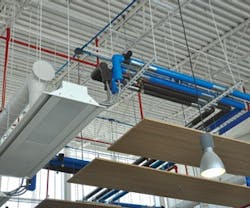Chilled beam cooling technology is commonly perceived as a system fit for mild climates – hence its popularity in Europe, where weather conditions rarely approach that of the southern U.S.
But a hot, humid environment doesn’t preclude the use of this super-efficient system. It simply means that you need to pair your chilled beams with dehumidifying equipment, such as a savings-boosting energy recovery wheel.
Take Control of Humidity
If the peak cooling season in your area exceeds a dew point of 64 degrees F., you need an efficient primary air system to deliver dehumidified outdoor air to the beams.
An energy recovery system sucks in outside air and passes it through a dry, cool zone of its enthalpy (recovery) wheel. The air then flows through a cooling coil and, if it’s a dual-wheel system, a sensible (dry) heat wheel that partially reheats the air to prevent overcooling. Some systems replace the sensible wheel with a passive dehumidification version to remove additional moisture.
“Anytime you have cold exposed surfaces inside the space, pay attention to the dew point,” says Rob Bolin, senior vice president and director of the High-Performance Solutions team at Syska Hennessy Group, a consulting, engineering, technology, and construction firm. “You need to measure the supply temperature, the temperature of the air you’re putting into the space, and the temperature and relative humidity of the space.”
Stay Dry during Humid Conditions
At the new 110,470-square-foot Raleigh Transit Operations Facility in Raleigh, NC, project architect Mike Talbot paired 80 chilled beams with 13 recovery units (three of which were dual-wheel) to deliver cool outdoor air to the facility’s administrative, operations, and maintenance wings.
The building serves Raleigh’s entire public transit system and offers lockers, shower rooms, and other amenities to drivers, all of whom start and end their routes there. This emphasis on comfort led the team to target 50% humidity year-round while still maintaining energy efficiency.
Ultimately, the facility’s energy use beat ASHRAE 90.1 standards by 50% – far above North Carolina’s requirement of 30% for government buildings over 20,000 square feet. This and other green features earned the facility LEED-NC Platinum certification.
The recovery units also ensure indoor humidity stays between 30-55% all year. Coupling recovery units with a humidifier for dry winter months allows you even tighter control over the humidity range. Meanwhile, the facility’s equipment recovers heat from building exhaust, and its heating and cooling coils modulate only as needed.
“We did a lifecycle cost study analysis that looked at chilled beams, ground source heat pumps, lighting controls, and occupancy sensors,” says Talbot, a certified building commissioning agent with Talbot & Associates Consulting Engineers. “The chilled beams had the lowest operating cost without much of a premium on the first cost.”
Consider Space Suitability
Chilled beam retrofits aren’t difficult when they’re matched with the right spaces, says Bolin. They're not suited for areas with high latent (moist) loads, constant humid conditions, or large quantities of unconditioned air, such as lobbies, vestibules, atriums, and pools.
“Let’s say it’s a conference room and you want to convert a conventional VAV system to an active chilled beam system,” Bolin explains. “All you have to do is take out the diffusers, replace them with chilled beams, and then balance the amount of primary air delivered to that space.”
Consider strategies to prevent condensation as you move forward. If the beams sweat, they'll drip.
“We put dew point sensors throughout the building so that if the chilled water provided to the beam was a lower temperature than the space dew point, it would eliminate flow to the chilled beams,” Talbot says. “There are also condensate sensors you can strap onto the pipe.”
Areas with exterior doors are vulnerable to humidity if the positive pressure isn’t right, says Ola Ferm, partner at Williard Ferm Architects, which designed the Raleigh facility. “Our climate gets 98% humidity, so the key is to control it,” Ferm explains. “The system is only as good as the person who designs it.”
Janelle Penny ([email protected]) is associate editor of BUILDINGS.
About the Author
Janelle Penny
Editor-in-Chief at BUILDINGS
Janelle Penny has been with BUILDINGS since 2010. She is a two-time FOLIO: Eddie award winner who aims to deliver practical, actionable content for building owners and facilities professionals.

